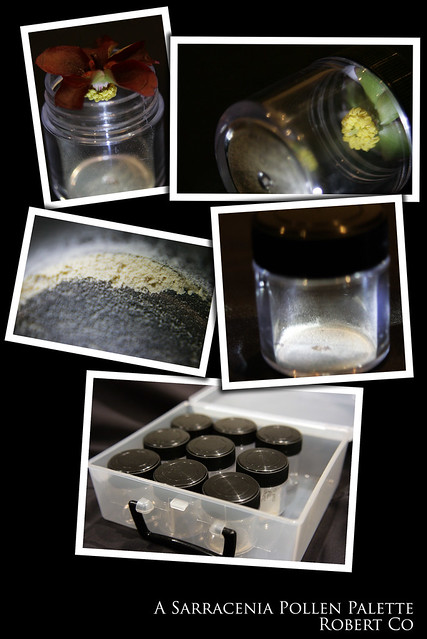Hope everyone found Brook Garcia’s pollination tutorial helpful! I sure did! Again, everyone has their own methods and variations on how to pollinate. My suggestion is — do whatever works best for you! Don’t be afraid to try new things. Anyway, so in 2009 when I wanted to store the pollen to create crosses with plants that don’t bloom at the same time, I figured I could store pollen in little containers that were available at a local craft store. I didn’t really want to keep the pollen on a q-tip as I wanted to be able to spread that pollen around to more plants. Saving the pollen in the container would allow me a little bit more control. So being the uber plant nerd I am — I stored the pollen. Actually, it was fellow grower and friend Jacob Farin who called me a Sarracenia nerd when he saw what I was doing. (OK, yes, I am a Sarracenia nerd. I admit. And I’m PROUD!! YEAH!!)
Yes, that is correct. I stored the pollen.
In little pollen containers.
In a pollen case.
In the pollen storage section of my fridge.
Next to the bacon. You MUST store it next to bacon. If you didn’t know, pollen storage next to bacon actually keeps it viable longer.
(Actually — the fridge keeps the pollen viable longer, not the bacon. But yes, eat bacon. It is good for you.)
You can’t really see it in the photo, but I did tag those cases so I knew what pollen was being used. Good record keeping is key, and organization is a good practice.
When it came time for the pod parent to open up and bloom – I just simply took my uber-nerdy pollen case and my even more super uber-nerdy pollen brushes and pollinated away! Here’s a photo from April 2009 of my “Sarracenia Pollen Palette”.
 [A Sarracenia Pollen Palette. It’s nerdy. But it works.]
[A Sarracenia Pollen Palette. It’s nerdy. But it works.]




 [Pitcher plant in creation.]
[Pitcher plant in creation.]


